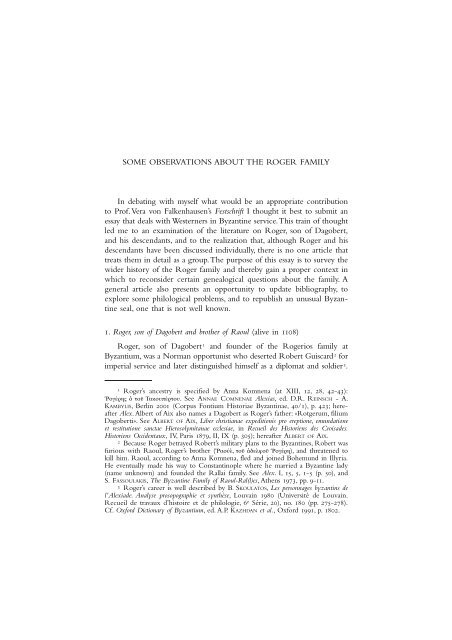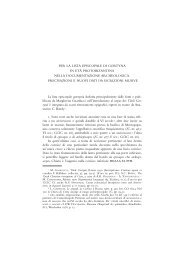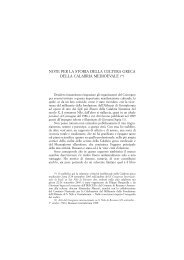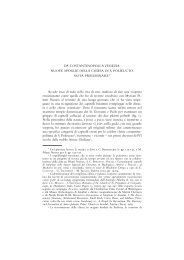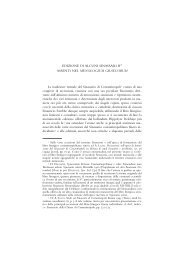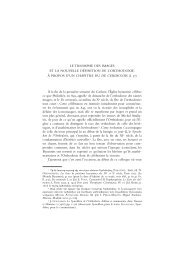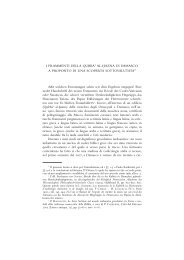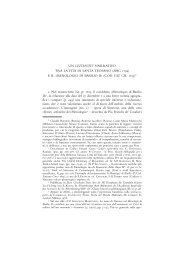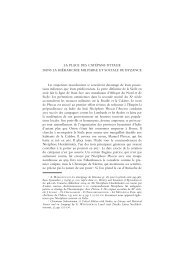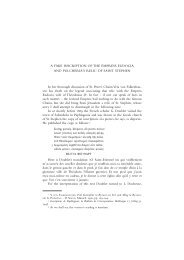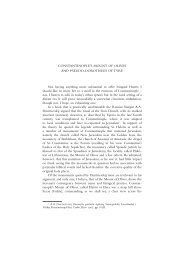John Nesbitt
John Nesbitt
John Nesbitt
Create successful ePaper yourself
Turn your PDF publications into a flip-book with our unique Google optimized e-Paper software.
SOME OBSERVATIONS ABOUT THE ROGER FAMILY<br />
209<br />
In debating with myself what would be an appropriate contribution<br />
to Prof.Vera von Falkenhausen’s Festschrift I thought it best to submit an<br />
essay that deals with Westerners in Byzantine service.This train of thought<br />
led me to an examination of the literature on Roger, son of Dagobert,<br />
and his descendants, and to the realization that, although Roger and his<br />
descendants have been discussed individually, there is no one article that<br />
treats them in detail as a group.The purpose of this essay is to survey the<br />
wider history of the Roger family and thereby gain a proper context in<br />
which to reconsider certain genealogical questions about the family. A<br />
general article also presents an opportunity to update bibliography, to<br />
explore some philological problems, and to republish an unusual Byzantine<br />
seal, one that is not well known.<br />
1. Roger, son of Dagobert and brother of Raoul (alive in 1108)<br />
Roger, son of Dagobert 1 and founder of the Rogerios family at<br />
Byzantium, was a Norman opportunist who deserted Robert Guiscard 2 for<br />
imperial service and later distinguished himself as a diplomat and soldier 3 .<br />
1 Roger’s ancestry is specified by Anna Komnena (at XIII, 12, 28, 42-43):<br />
Ργέρης τ Τακυπέρτυ. See ANNAE COMNENAE Alexias, ed. D.R. REINSCH - A.<br />
KAMBYLIS, Berlin 2001 (Corpus Fontium Historiae Byzantinae, 40/1), p. 423; hereafter<br />
Alex. Albert of Aix also names a Dagobert as Roger’s father: «Rotgerum, filium<br />
Dagoberti». See ALBERT OF AIX, Liber christianae expeditionis pro ereptione, emundatione<br />
et restitutione sanctae Hierosolymitanae ecclesiae, in Recueil des Historiens des Croisades.<br />
Historiens Occidentaux, IV, Paris 1879, II, IX (p. 305); hereafter ALBERT OF AIX.<br />
2 Because Roger betrayed Robert’s military plans to the Byzantines, Robert was<br />
furious with Raoul, Roger’s brother (Ραλ, τ δελ Ργέρη), and threatened to<br />
kill him. Raoul, according to Anna Komnena, fled and joined Bohemund in Illyria.<br />
He eventually made his way to Constantinople where he married a Byzantine lady<br />
(name unknown) and founded the Rallai family. See Alex. I,15, 5, 1-5 (p. 50), and<br />
S. FASSOULAKIS, The Byzantine Family of Raoul-Ral(l)es, Athens 1973, pp.9-11.<br />
3 Roger’s career is well described by B. SKOULATOS, Les personnages byzantins de<br />
l’Alexiade. Analyse prosopographie et synthèse, Louvain 1980 (Université de Louvain.<br />
Recueil de travaux d’histoire et de philologie, 6 e Série, 20), no. 180 (pp. 275-278).<br />
Cf. Oxford Dictionary of Byzantium, ed. A.P. KAZHDAN et al., Oxford 1991, p.1802.
210<br />
JOHN NESBITT<br />
About 1079 Robert Guiscard had sent from Salerno Roger’s brother,<br />
Raoul, to Constantinople to inform Emperor Nikephoros III that he was<br />
aggrieved by the emperor’s usurpation of power and his decision to disallow<br />
the marriage of his predecessor’s son, Constantine Doukas, to Robert’s<br />
daughter, Helena. Robert hoped to use this situation as an excuse for war.<br />
When Raoul rejoined Guiscard’s court, this time at Brindisi, where the<br />
duke of Apulia and Calabria was assembling an invasion force, he informed<br />
his master that Alexios Komnenos had assumed the imperial mantle and<br />
had elected to grant Constantine Doukas a share in the empire’s governance.<br />
Hence Guiscard had no legal basis for attacking Byzantium. At this<br />
juncture Raoul’s brother, Roger, decided to leave Brindisi and to betray<br />
Robert’s pre-emptive strike against Byzantine territory to imperial authorities.We<br />
next hear of Roger some fifteen years later. In 1096 Alexios Komnenos<br />
sent Roger and Rudolfus Pel-de-Leu to negotiate with Godfrey<br />
of Bouillon, duke of Lower Lorraine, regarding the passage of crusaders<br />
through Byzantine lands and their conduct 4 . In 1108, Alexios consulted<br />
with Roger, the sebastos Marinos of Naples and Peter of Aulps, regarding a<br />
plan to sow dissension among Bohemund’s forces 5 . Afterwards Alexios<br />
sent Roger to Bohemund as a hostage, along with Marinos of Naples,<br />
Adralestos and Constantine Euphorbenos 6 . His name appears among the<br />
signatories of the peace treaty of September, 1108 7 . At some point in his<br />
career he received the title of sebastos. For upon his death Kallikles composed<br />
an epitaph entitled ες τν τάν Ργερίυ τ σεαστ 8 . The poet<br />
alludes to Roger’s earlier exploits in Italy 9 and intimates that Roger participated<br />
in expeditions against the Pechenegs and Turks («the Celts and<br />
the Istrian Scyths and the sons of the Persians shout my brave deeds») 10 .<br />
4 ALBERT OF AIX, II, IX (p. 305). The crusaders were proceeding from Adrianople<br />
to the capital and on the way were robbing Byzantine citizens and destroying<br />
property.<br />
5 Alex., XIII, 4, 4 (p. 395).<br />
6 Alex., XIII, 9, 1 (pp. 407-408).<br />
7 Alex., XIII, 12, 28, 42-43 (p. 423).<br />
8 NICOLA CALLICLE, Carmi. Testo critico, introduzione, traduzione, commentario e<br />
lessico, ed. R. ROMANO, Naples 1980 (Byzantina et neohellenica neapolitana, Collana<br />
di Studi e Testi diretta da Antonio Garzya), no. 19 (pp. 93-95). Specification of his<br />
rank is repeated in line 34 (p. 94) where there is mention of enrollment in the ranks<br />
of the sebastoi (τ τν σεαστν νι πρσεγράην).<br />
9 CALLICLE, Carmi cit., lines 23-29 (p. 94).<br />
10 CALLICLE, Carmi cit., lines 37-39 (p. 94): κα τς µς ντεθεν νδραγαθίας /<br />
Κελτ σιν κα παρίστριι Σκθαι / κα τέκνα Περσν...
SOME OBSERVATIONS ABOUT THE ROGER FAMILY 211<br />
Mention of the Pechenegs suggests that Roger may have participated in<br />
the campaigns against them of 1087 or been present at the battle of Mt.<br />
Lebounion where the Pechenegs sustained a crushing defeat in 1091.<br />
Finally Kallikles indicates that Roger married a prominent lady and that<br />
the union produced offspring («golden sons») 11 .<br />
2. Constantine Roger (dead by 1136)<br />
Constantine Roger, sebastos, is known solely from a reference in the<br />
Pantokrator Typikon (date: October 1136) of Emperor <strong>John</strong> II Komnenos 12 .<br />
The document specifies that, along with others, Constantine Roger, sebastos,<br />
should be remembered on the Saturdays of Meatfare, Cheesefare,<br />
and Pentecost.<br />
3. <strong>John</strong> Roger-Dalassenos (dead after 1166)<br />
In 1144/1145, while Emperor Manuel was having a fort constructed<br />
in the region of Melangia, news reached him that «the eldest daughter of<br />
Emperor <strong>John</strong>, whom Caesar Roger had married, was sick and in danger<br />
of her life»: ς τ πρεσυτάτη τν ασιλέως Ιωάννυ θυγατέρων, ν κασαρ<br />
γάγετ Ργέρις, νσς πιγεγνυα υκτν πγράει τν κίνδυνν 13 .In<br />
the end the lady, named Maria, died. Our informant, the historian <strong>John</strong><br />
Kinnamos, goes on to say that when <strong>John</strong> II died (April, 1143) Roger<br />
(reportedly) had designs on the imperial throne and attracted to his<br />
cause some four hundred adherents, including Prince Robert, the former<br />
governor of Capua, who was then living in the capital. Roger’s wife,<br />
Maria, opposed her husband’s ambitions and unable to dissuade him<br />
exposed the plot to officials loyal to her brother.The conspiracy came to<br />
11 CALLICLE, Carmi cit., lines 35 and 36: κα κδς σν κ µεταρσίυ γένυς / κα<br />
τέκνα ρυσ...<br />
12 P. GAUTIER, Le typikon du Christ Sauveur Pantocrator, in Revue des études byzantines<br />
32 (1974), pp. 44-45: σεαστς κρις Κωνσταντνς Ργέρης.<br />
13 IOANNIS CINNAMI epitome rerum ab Ioanne et Alexio Comnenis gestarum, ed. A.<br />
MEINEKE, Bonn 1836, p.36; hereafter KINNAMOS. There are two excellent studies of<br />
<strong>John</strong> Roger’s life. See J.-C. CHEYNET - J.-F. VANNIER, Études prosopographiques, Paris<br />
1986 (Byzantina Sorbonensia, 5), no. 30 (pp. 112-113); and L. STIERNON, Notes de titulature<br />
et de prosopographie byzantines: à propos de trois membres de la famille Rogérios<br />
(XII siècle), in Revue des études byzantines 22 (1964), pp. 185-187. According to Barzos<br />
Maria was born about 1106/1107 and married <strong>John</strong> Roger-Dalassenos about 1121.<br />
See K. BARZOS, Η γενεαλγία τν Κµνηνν, Thessalonika 1984 (Βυαντιν κείµενα κα<br />
µελέται, 20 Α), pp. 348-349.
212<br />
JOHN NESBITT<br />
nothing, as Manuel’s advisors enticed Roger into accompanying them to<br />
a suburb near Constantinople where he was detained 14 .<br />
Lucien Stiernon has convincingly shown that Kinnamos’ Roger is <strong>John</strong><br />
Dalassenos.Why does Kinnamos call <strong>John</strong> Dalassenos by his father’s name?<br />
Kinnamos describes Robert of Capua as an «Italian compatriot» 15 . By using<br />
the name «Roger», and so calling attention to the caesar’s Norman ancestry,<br />
he is not obliged to offer any explanation of his choice of phraseology.<br />
Upon <strong>John</strong> Roger-Dalassenos’ marriage to Maria, he received the<br />
title of panhypersebastos. The conferral of this title is known to us from a<br />
seal published by G. Zacos and A.Veglery 16 . The obverse features a representation<br />
of the Virgin partially turned and her hands raised towards<br />
the manus Dei. On the reverse appears an inscription imploring the Virgin<br />
to watch over the «despotes panhypersebastos <strong>John</strong> Dalassenos». He<br />
obtained the title of Caesar following the death of Nikephoros Bryennios<br />
(about 1138) 17 . Although he had cast a covetous eye on the imperial<br />
throne when <strong>John</strong> II died, Manuel I seems not to have held any permanent<br />
grudge. Under the designation «lord <strong>John</strong> Caesar» Dalassenos is<br />
recorded as a participant in a council of 1147 at Constantinople that<br />
deposed Patriarch Kosmas Attikos 18 . In 1151/1152, <strong>John</strong> Dalassenos was<br />
despatched to Antioch. Manuel was hopeful that Constance, the widow<br />
of Raymond, would marry the widower <strong>John</strong> Dalassenos, and that<br />
thereby Antioch would fall under Byzantine control. But, as Kinnamos<br />
reports, the plan came to nothing. Constance found him to be too aged<br />
a suitor and so he returned to Byzantium where he fell ill and took the<br />
14 KINNAMOS cit., pp. 37-38.<br />
15 KINNAMOS cit., p. 37: κα δ κα τν τινα Ιταλιωτν γένυς συµπατριώτην ατ τ<br />
πατρθεν ντα. Apparently Roger’s father had brought Robert of Capua within the<br />
family circle as a companion for his son.<br />
16 See their Byzantine Lead Seals,I.3, Basel 1972,no.2721.The specimen, which<br />
is from the Dumbarton Oaks Collection (DO 58.106.5518) is reproduced with commentary<br />
by N. OIKONOMIDES, A Collection of Dated Byzantine Lead Seals ,Washington<br />
DC 1986, no.116. The legend on the reverse reads: Τν ∆αλασηνν δεσπτην Ιωάνην /<br />
τν πανυπερσέαστν, Ανασσα, σκέπις.<br />
17 For seals of <strong>John</strong> Dalassenos as Caesar, see ZACOS and VEGLERY cit., I.3, no.<br />
2722; and V. LAURENT, Les bulles métriques dans la sigillographie byzantine, Paris 1932<br />
(Archives de l’Orient chrétien, 2), no. 724.Cf.OIKONOMIDES cit., no. 117.The several<br />
specimens, although from different boulloteria, bear the same inscription on the<br />
reverse: Τν ∆αλασηνν δεσπτην Ιωάννην / τν ετυ καίσαρα, Παρθένε, σκέπις.<br />
18 J.-B. MANSI, Sacrorum conciliorum nova et amplissima collectio, 21, Venice 1776;<br />
rpr. 1903, col. 701. His name is given in Latin translation as «domino Joanne Rogerio»<br />
(col. 702).
SOME OBSERVATIONS ABOUT THE ROGER FAMILY 213<br />
habit of a monk 19 . The date of his death is problematic. In the opening<br />
statement of a synodal act of March 6, 1166, there is mention of <strong>John</strong><br />
Roger-Dalassenos’ son Andronikos. He is identified as Ανδρνίκυ τ<br />
υ τ Καίσαρς 20 . If Andronikos’ father were dead, one would expect<br />
him to be identified as the son of the late Caesar. In our opinion <strong>John</strong><br />
Roger-Dalassenos overcame his illness in 1152 and was alive in March of<br />
1166.There is one additional consideration. In a praktikon of July 7, 1152,<br />
we are informed that Michael Tzankitzakes the «servitor of the Caesar»<br />
(δλω τ... καίσαρς) was engaged in reviewing tax levies in the region<br />
of Stroumitza after receiving grievances from Dionysios, the head of the<br />
monastery of Eleousa 21 .This episode may reflect (as some reasonably suppose)<br />
that in July of 1152 <strong>John</strong> Roger-Dalassenos was governor of the<br />
region of Stroumitza. If so, then there would be further reason to believe<br />
that he survived his illness quite handily and instead of remaining in a<br />
monastery returned to the world and became active in administration.<br />
4. Andronikos Komnenos (dead after 1166, perhaps after 1191)<br />
The union of <strong>John</strong> Roger-Dalassenos and Maria, the eldest daughter of<br />
<strong>John</strong> II, produced at least two daughters, Anna and Theodora, and at least<br />
two sons,Andronikos and Alexios 22 .Andronikos bore the name of his mother.<br />
This is evident from a seal published by Laurent: Σράγισµα γραν<br />
∆υκυς Ερήνης / Κµνηνς Ανδρνικς υνεγη / ατκρατντς<br />
Μανυλ δελπαις / κ πρυρανθς ασιλίσσης Μαρίας: «This is the seal of<br />
the writings of Eirene Doukaina, wife of Andronikos Komnenos, son of the<br />
sister of the autokrator Manuel, the basilissa, born in the purple, Maria» 23 .<br />
Barzos dates Andronikos’ marriage to Eirene Doukaina to the period about<br />
1139. In the synodal act of March 1166, noted above, Andronikos is denom-<br />
19 KINNAMOS cit., pp. 122-123 and 178. In addition her subjects were concerned<br />
that they would fall prey to exactions by the Byzantine fisc.<br />
20 NIKETAS CHONIATES, Ex libro VI Thesauri orthodoxae fidei [Patrologiae cursus completus.<br />
Series graeca, accurante J.-P. MIGNE, CXL, Paris 1887, col. 253 A].<br />
21 L. PETIT, Le Monastère de Notre-Dame de Pitié en Macedoine, in Bulletin de l’Institut<br />
Archéologique Russe de Constantinople 6 (1900), pp. 34 and 46. The latest edition<br />
of the praktikon is to be found in the third volume of Actes d’Iviron, ed. J. LEFORT et<br />
al., Paris 1994, pp.76-82; see especially pp. 76 and 82.<br />
22 <strong>John</strong>’s offspring are discussed in BARZOS, Γενεαλγία cit., part Β, nos. 124, 125,<br />
126 and 127. Barzos places Andronikos’ birth about 1124 and Alexios’ birth between<br />
1127 and 1130.<br />
23 LAURENT, Bulles métriques cit., no. 470.
214<br />
JOHN NESBITT<br />
inated quite simply as the «son of the Caesar». His brother Alexios was married<br />
to Eirene Petraliphaina. Barzos assigns this event to the period of 1150.<br />
It is possible that Andronikos and his brother Alexios were in attendance at<br />
the synod of 1191, as there is mention of τ πανσεάστυ σεαστ κυρ<br />
Ανδρνίκυ τ Κµνην, τ πανσεάστυ σεαστ κυρ Αλείυ τ Κ-<br />
µνην 24 . But Stiernon has cautioned that these two personages might be the<br />
sons either of Theodore Vatatzes or of <strong>John</strong> Roger-Dalassenos 25 .<br />
One of Stiernon’s main contributions to discussion is his recognition<br />
that Andronikos Komnenos is to be distinguished from Andronikos Roger.<br />
5. Andronikos Roger (alive in 1191)<br />
There are several references to this individual.The same document of<br />
1191 that mentions the two Komnenoi refers to Andronikos Roger in<br />
the following terms: τ πανσεάστω σεαστ κειτάτω τ κραται κα<br />
γίω µν ασιλε, πρκαθηµένω τν ν τ θερυρήτω παλατίω τν<br />
Βλαερνν υλασσντων πριµµικηρίων κα στρατιωτν κυρ Ανδρνίκω τ<br />
Ργερίω 26 . In 1191 Andronikos Roger, who was commissioned to reinstall<br />
upon his throne at Jerusalem Patriarch Dositheos, held the dignity<br />
of pansebastos sebastos and exercised the function of prokathemenos («chief»)<br />
of the primmikerioi and soldiers stationed at the Blachernae palace 27 . His<br />
name is also found on a seal published in an obscure article by V. Laurent<br />
nearly fifty years ago 28 . Laurent observed that the specimen is<br />
no. 387 in his unpublished catalogue of the Shaw collection; preserved<br />
at Dumbarton Oaks it bears today the accession number DO 47.2.1080<br />
(figs. 1 a and b). On the obverse one finds a scene consisting of an icon<br />
of the Virgin (at upper left) set on a dais. The Virgin, who is depicted<br />
24 A. PAPADOPOULOS-KERAMEUS, Ανάλεκτα ερσλυµιτικς σταυλγίας, II, St. Petersburg<br />
1894; repr. 1963, p.362, lines 19-21.<br />
25 STIERNON, Trois membres cit., p. 197.<br />
26 PAPADOPOULOS-KERAMEUS, Ανάλεκτα ερσλυµιτικς σταυλγίας cit., p. 367.<br />
27 The office of πρκαθήµενς τν Βλαερνν is listed in an appendix to Harmenopoulos’<br />
Hexabiblos: see PSEUDO-KODINOS, Traité des offices, ed. with translation by<br />
J.VERPEAUX, Paris 1966,p.301, lines 29-30; cf. the Index grec, p. 406, under prokathemenos.<br />
There were prokathemenoi of palaces and towns. See, for example, the thirteenth-century<br />
seal of <strong>John</strong> Spartianos, prokathemenos of Thessalonika, listed in Studies<br />
in Byzantine Sigillography 6, Washington, DC 1999, p.104. Cf.KAZHDAN, Oxford<br />
Dictionary of Byzantium cit., p. 1729.<br />
28 Andronic Rogérios, fondateur du couvent de la Théotokos Chrysokamariotissa et son<br />
sceau inédit au type de l’offrande, in Académie Roumaine. Bulletin de la section historique 27<br />
(1946), pp. 74-75.
SOME OBSERVATIONS ABOUT THE ROGER FAMILY 215<br />
Fig. 1a Fig. 1b<br />
half-length, holds Christ on her left arm and is surrounded by the usual<br />
sigla: Μ(ήτη)ρ Θ(ε). At right a figure of smaller dimensions (undoubtedly<br />
Andronikos Rogerios) has placed his foot on the edge of the dais,<br />
while proffering a model of a church. Along the circumference appears<br />
an inscription reading: Σκέπις µε ρυσπαστε παστς Κυρίυ. On the reverse<br />
one finds in center a monogram which Laurent read as Γ(ε)ωργίω,<br />
but in actuality is to be resolved as Ρωγ(έ)ρις. Along the circumference<br />
is set an inscription reading: Σεαστν Ανδρνικν κ Ρωγερίων. The two<br />
inscriptions may be translated as follows: «You, oh bridal chamber of the<br />
Lord, ornamented with gold, protect me sebastos Andronikos, descendant of<br />
the Roger family». Finally Andronikos Roger is remembered in an epigram<br />
of Theodore Balsamon commemorating Andronikos’ foundation of a<br />
monastery «called Chrysokamariotissa» 29 . Janin lists the monastery among<br />
the religious establishments of Constantinople 30 , yet offers no explanation<br />
why anyone should believe that it was located at the capital. It probably<br />
was and for the evidence see our discussion below.<br />
Curiously Laurent describes the adjective ρυσπαστε as a hapax legomenon.<br />
One will find the word, however, in the metrical history of<br />
the 12 th -century writer Constantine Manasses: κα πέπλις ρυσπάστις<br />
(at 5060; Bonn ed.) 31 . To what does ρυσπαστε refer? Laurent is un-<br />
29 The poem is entitled: Ες τυπικν τς µνς τ σεαστ κα πρκαθηµένυ κρ<br />
Ανδρνίκυ Ργερίυ τς λεγµένης ρυσκαµαριωτίσσης. See K. HORNA, Die Epigramme<br />
des Theodoros Balsamon, in Wiener Studien 25 (1903), no. XXVIII (pp. 191-192). In<br />
lines 5 and 6 Andronikos’ dignity and lineage is referred to within the body of the<br />
poem: θεν σεαστς Ανδρνικς, γένς στι περιητν κ Ρωγερίων.<br />
30 R. JANIN, La géographie ecclésiastique de l’empire byzantin, III: Les églises et les<br />
monastères, 2 nd ed., Paris 1969, p.242.<br />
31 Breviarium historiae metricum, ed. I. BEKKER (Bonn 1837), p. 216. In the new<br />
edition of O. LAMPSIDIS, Constantini Manassis breviarium chronicum, Athens 1996, the
216<br />
JOHN NESBITT<br />
doubtedly correct that the noun παστς alludes to the Virgin and is used<br />
in the metaphorical sense of the bridal chamber (or «temple», as Laurent<br />
has translated the word) wherein has occurred the union of the Word<br />
with human nature 32 . In our opinion the adjective ρυσπαστε relates to<br />
the physical character of the icon which Andronikos approaches; it denotes<br />
that this icon of the Virgin (or icon of the «bridal chamber») has<br />
been «worked with gold».<br />
Our seal and Balsamon’s epigram establish that Andronikos Rogerios<br />
founded a monastic complex called the «Theotokos Chrysokamariotissa».<br />
We agree with Laurent’s conclusion that the phrase is not to be interpreted<br />
as expressive of a theological concept, but would like to modify Laurent’s<br />
notion that the epithet relates to the decoration of the monastery’s main<br />
church. In our opinion the epithet is based in architecture, but refers to a<br />
specific arch or vault in Constantinople, the Chrysokamaron (τ ρυσκά-<br />
µαρν), and by extension to the area where the Chrysokamaron was located.<br />
According to legend a golden statue stood at the site of the Chrysokamaron<br />
(presumably below a «golden arch», perhaps an arch or vault<br />
decorated with gold) 33 , a structure that was located behind the Myrelaion.<br />
If we are correct, the monastery of the Theotokos Chrysokamariotissa derived<br />
its name from a location where there had stood or still stood an architectural<br />
element adorned with gold or of golden color.<br />
In conclusion we would like to turn to a question of genealogy.<br />
Jean-Claude Cheynet has expressed the opinion that <strong>John</strong> Roger-<br />
Dalassenos was the son of Constantine Roger 34 . Certainly Cheynet is<br />
correct, based upon Kallikles’ testimony, that the lady of high lineage<br />
whom Roger married was a member of the Dalassenos family and that<br />
this union would explain why Constantine Roger (a probable offspring<br />
of the marriage) should obtain the dignity of sebastos. On the other<br />
hand, Constantine Roger does not hold in the Pantokrator list a very<br />
exalted place among those who are to be remembered. His name appears<br />
phrase appears at 4982 (p. 270). See also Theophanes Continuatus, Ioannes Cameniata,<br />
Symeon Magister, Georgius Monachus, ed. I. BEKKER (Bonn 1838), p. 677, line 11: πέρδι<br />
ρυσπαστς.<br />
32 LAURENT, Andronic Rogérios cit., p. 77.<br />
33 R. JANIN, Constantinople byzantine, 2 nd ed., Paris 1964 (Archives de l’orient<br />
latin, 4 A), p. 331.<br />
34 See CHEYNET - VANNIER, Études prosopographiques cit., p. 112.BARZOS, Η γενεαλγία<br />
cit., p. 349 and footnote 7, is of a similar opinion. For Gautier Constantine was<br />
a brother: P. GAUTIER, L’obituaire du typikon du Pantokrator, in Revue des études byzantines<br />
27 (1969), p. 255.
SOME OBSERVATIONS ABOUT THE ROGER FAMILY 217<br />
after a eunuch and a mystikos. If Constantine Roger were the emperor’s<br />
father-in-law, one would expect a more prestigious place. In sum, we<br />
tend to believe that <strong>John</strong> Roger-Dalassenos, who married Maria, the<br />
daughter of <strong>John</strong> II, was the son of Rogerios, the Norman adventurer<br />
who capped his career by marrying a member of the Dalassenos family<br />
and receiving the dignity of sebastos 35 .<br />
JOHN NESBITT<br />
35 This is the same conclusion expressed by KAZHDAN, Oxford Dictionary of Byzantium<br />
cit., p. 1802. Two further observations: the seal of Constantine Roger, published<br />
by C. STAVRAKOS, Die byzantinischen Bleisiegel mit Familiennamen aus der Sammlung<br />
des Numismatischen Museum Athen,Wiesbaden 2000,no.221, dates from a period<br />
later than 1136; the seal of Andronikos Roger, published in Pliska-Preslav 9, Shumen<br />
2003, p.37, no.11, is modern.<br />
Pag. 218 bianca


